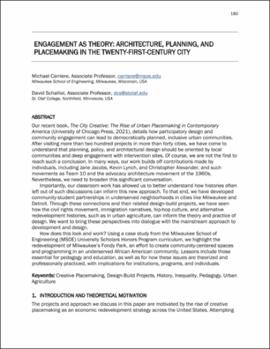| dc.contributor.author | Carriere, Michael | |
| dc.contributor.author | Schalliol, David | |
| dc.date.accessioned | 2022-03-23T20:44:57Z | |
| dc.date.available | 2022-03-23T20:44:57Z | |
| dc.date.issued | 2022 | |
| dc.identifier.citation | Carriere, Michael and David Schalliol, "Engagement as Theory: Architecture, Planning, and Placemaking in the Twenty-First Century City," in Person, Angela M., Anthony Cricchio, and Stephanie Z. Pilat, eds. 2022. Proceedings of Schools of Thought: Rethinking Architectural Pedagogy, Norman, Oklahoma, March 5-7, 2020. University of Oklahoma Libraries: ShareOK. | |
| dc.identifier.uri | https://hdl.handle.net/11244/335068 | |
| dc.description | This paper was presented at the 2020 Schools of Thought Conference hosted by the Christopher C. Gibbs College of Architecture at the University of Oklahoma. | |
| dc.description.abstract | Our recent book, "The City Creative: The Rise of Urban Placemaking in Contemporary America" (University of Chicago Press, 2021), details how participatory design and community engagement can lead to democratically planned, inclusive urban communities. After visiting more than two hundred projects in more than forty cities, we have come to understand that planning, policy, and architectural design should be oriented by local communities and deep engagement with intervention sites. Of course, we are not the first to reach such a conclusion. In many ways, our work builds off contributions made by individuals, including Jane Jacobs, Kevin Lynch, and Christopher Alexander, and such movements as Team 10 and the advocacy architecture movement of the 1960s. Nevertheless, we need to broaden this significant conversation. Importantly, our classroom work has allowed us to better understand how histories often left out of such discussions can inform this new approach. To that end, we have developed community-student partnerships in underserved neighborhoods in cities like Milwaukee and Detroit. Through these connections and their related design-build projects, we have seen how the civil rights movement, immigration narratives, hip-hop culture, and alternative redevelopment histories, such as in urban agriculture, can inform the theory and practice of design. We want to bring these perspectives into dialogue with the mainstream approach to development and design. How does this look and work? Using a case study from the Milwaukee School of Engineering (MSOE) University Scholars Honors Program curriculum, we highlight the redevelopment of Milwaukee’s Fondy Park, an effort to create community-centered spaces and programming in an underserved African American community. Lessons include those essential for pedagogy and education, as well as for how these issues are theorized and professionally practiced, with implications for institutions, programs, and individuals. | |
| dc.language.iso | en_US | |
| dc.relation.ispartof | 2020 Schools of Thought Conference | |
| dc.relation.uri | https://hdl.handle.net/11244/335058 | |
| dc.rights | CC BY-NC-SA | |
| dc.rights.uri | https://creativecommons.org/licenses/by-nc-sa/4.0/ | |
| dc.subject | creative placemaking | |
| dc.subject | design-build projects | |
| dc.subject | history | |
| dc.subject | inequality | |
| dc.subject | pedagogy | |
| dc.subject | urban agriculture | |
| dc.title | Engagement as Theory: Architecture, Planning, and Placemaking in the Twenty-First Century City | |
| dc.type | Article | |
| dc.description.peerreview | Yes | |
| dc.identifier.doi | 10.15763/11244/335068 | |
| ou.group | Christopher C. Gibbs College of Architecture | |



